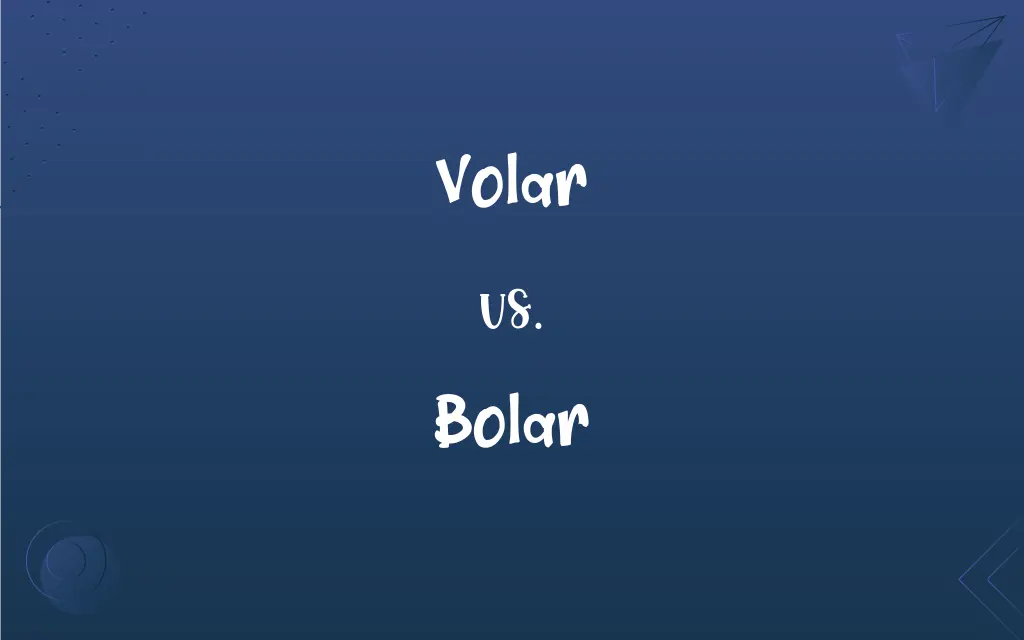Volar vs. Bolar: What's the Difference?
By Aimie Carlson || Updated on May 22, 2024
"Volar" pertains to the palm side of the hand or the sole of the foot, while "Bolar" refers to a type of clay used in pottery and ceramics.

Key Differences
Volar is a term primarily used in anatomy to describe the palm side of the hand or the sole of the foot. It is derived from the Latin word "vola," meaning "palm." This term is often used in medical contexts to specify locations, conditions, or surgical procedures related to these areas. Bolar, on the other hand, refers to a specific type of fine clay used in pottery and ceramics. It is known for its plasticity and workability, making it a preferred material for creating detailed and delicate ceramic pieces. The term is less commonly encountered but is significant in the field of ceramics and pottery.
In medical settings, volar is used to describe anatomical positions and injuries, such as volar fractures or volar splints. Bolar is used in artistic and industrial contexts, specifically in ceramics, where the quality of clay affects the final product's texture and durability.
Volar relates to human anatomy and is crucial for medical professionals in identifying and treating conditions related to the hand and foot. Bolar relates to material science and the arts, impacting the techniques and quality of ceramic products.
Comparison Chart
Definition
Pertaining to the palm or sole
A type of clay used in ceramics
Context
Anatomy and medicine
Pottery and ceramics
ADVERTISEMENT
Usage
Describing locations or injuries on hand/foot
Creating detailed ceramic pieces
Derived From
Latin "vola" meaning palm
Clay used for its plasticity
Application
Medical descriptions and treatments
Artistic and industrial ceramics
Volar and Bolar Definitions
Volar
Pertaining to the palm of the hand.
The volar surface of the hand was inspected for injuries.
Bolar
A type of clay used in ceramics.
The sculptor preferred bolar for its smooth texture.
ADVERTISEMENT
Volar
Relating to the sole of the foot.
She had a blister on the volar aspect of her foot.
Bolar
Favored in artistic and industrial ceramics.
The artist's signature pieces were crafted from bolar.
Volar
Used to describe anatomical features on the palm or sole.
Volar plates are thick ligaments found in the hand.
Bolar
Known for its plasticity in pottery.
Bolar clay allows for intricate detailing in pottery.
Volar
Indicative of injuries on the palm side.
The patient suffered a volar fracture.
Bolar
A fine clay suitable for making delicate ceramic pieces.
The pottery class used bolar to create their vases.
Volar
Referring to surgical procedures on the palm or sole.
The surgeon performed a volar release to alleviate the condition.
Bolar
Utilized in the production of high-quality ceramics.
Bolar clay was chosen for the porcelain figurines.
Volar
Of or relating to the sole of the foot or the palm of the hand.
Bolar
Of or relating to bole or clay; partaking of the nature and qualities of bole; clayey.
Volar
(anatomy) Pertaining to the palm of the hand or the sole of the foot.
Bolar
Of or pertaining to bole or clay; partaking of the nature and qualities of bole; clayey.
Volar
Of or pertaining to the palm of the hand or the sole of the foot.
Volar
Relating to the palm of the hand or the sole of the foot;
The volar surface
The palmar muscle
FAQs
Why is bolar clay preferred in ceramics?
Bolar clay is preferred for its smooth texture and ability to be molded into detailed shapes.
What is bolar clay?
Bolar is a type of fine clay used in pottery and ceramics for its plasticity and workability.
Where is the volar surface located?
The volar surface is located on the palm of the hand or the sole of the foot.
How is volar used in medical terms?
Volar is used to describe locations, conditions, or surgical procedures related to the palm or sole.
What are common uses for bolar clay?
Common uses for bolar clay include making pottery, sculptures, and other ceramic items.
What injuries might affect the volar side?
Injuries such as fractures, cuts, and blisters can affect the volar side of the hand or foot.
Can bolar clay be used for large ceramic pieces?
While it can be used for various sizes, bolar clay is especially valued for detailed and delicate work.
What is a volar splint?
A volar splint is a type of orthopedic device used to immobilize and support the wrist and hand.
What does volar mean in anatomy?
Volar refers to the palm side of the hand or the sole of the foot.
How does the texture of bolar clay benefit potters?
Its fine texture allows for smooth finishes and intricate details in ceramic art.
Can bolar clay be fired at high temperatures?
Yes, bolar clay can be fired at high temperatures, making it suitable for various ceramic techniques.
What procedures involve the volar side of the hand?
Procedures like volar release surgeries are performed to treat conditions like carpal tunnel syndrome.
Is bolar clay environmentally friendly?
Bolar clay, like most natural clays, is generally considered environmentally friendly.
Is bolar clay suitable for beginners in pottery?
Yes, its plasticity makes it an excellent choice for beginners learning to shape clay.
Can bolar clay be used in both functional and decorative pottery?
Yes, bolar clay is versatile and can be used for both functional items and decorative pieces.
Are there specific medical conditions associated with the volar side?
Conditions such as volar plate injuries and volar ganglions are associated with this area.
What type of medical imaging is used for volar injuries?
X-rays and MRIs are commonly used to diagnose volar injuries.
How does bolar clay compare to other clays?
Bolar clay is distinguished by its plasticity and suitability for fine, detailed work.
What is volar flexion?
Volar flexion refers to the bending movement towards the palm side of the hand.
What is the significance of the volar plate in the hand?
The volar plate is a ligament that stabilizes the finger joints and prevents hyperextension.
About Author
Written by
Aimie CarlsonAimie Carlson, holding a master's degree in English literature, is a fervent English language enthusiast. She lends her writing talents to Difference Wiki, a prominent website that specializes in comparisons, offering readers insightful analyses that both captivate and inform.































































